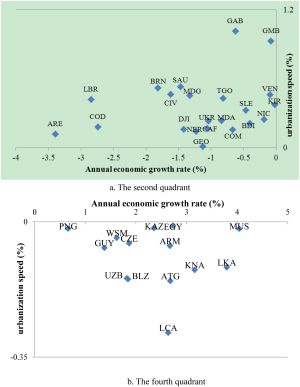Does Urbanization Always Drive Economic Growth? Not Exactly…
We often think of cities as major drivers of economic development and growth. Big cities expand our access to infrastructure like public transit and public education. They allow for more efficient distribution of social services such as government assistance and health care. Cities create large markets for business, and can attract international investment and tourism from around the world. They are hubs of non-agricultural, high-paying professional jobs like banking, law, and engineering. Diversity and face-to-face interactions can lead to new ideas and cross-cultural collaborations. Conventional wisdom holds that cities are good for the economy.
Indeed, the link between a country’s level of urbanization and the size of its gross domestic product (GDP) is well established. The below graph of 2011 data illustrates the strong positive correlation: developed countries with high GDPs have relatively high proportions of their population living in urban areas, and vice versa.
 Looking at this graph, it is small wonder, then, that urbanization has become a widely adopted global development strategy. National governments and international development agencies have embarked upon aggressive programs of accelerated urbanization designed to spur economic growth. Simply attract people into the cities, the thinking goes, and then cash in on the forthcoming economic benefits of a largely urban population. Well, it may be more complex than that, according to new research published in PLOS ONE.
Looking at this graph, it is small wonder, then, that urbanization has become a widely adopted global development strategy. National governments and international development agencies have embarked upon aggressive programs of accelerated urbanization designed to spur economic growth. Simply attract people into the cities, the thinking goes, and then cash in on the forthcoming economic benefits of a largely urban population. Well, it may be more complex than that, according to new research published in PLOS ONE.
Researchers in China examined global economic data on urbanization and per capita GDP levels spanning three decades (1980-2011). During this time, the proportion of the world’s population living in cities grew from just 39% in 1980 to 52% in 2011. And while urbanization and per capita GDP may be strongly correlated, the authors found no correlation between the rates of urbanization and economic growth. In other words, fast urban growth doesn’t always translate into fast GDP growth, as witnessed by the graph below. In stark contrast to the first graph, there is no easily discernible pattern connecting the speed of urbanization and the speed of GDP growth.
The authors also point out that over three decades, many countries—for example, Gabon—had rapidly growing urban populations but low and even negative economic growth (top graph in green below). Conversely, many countries, such as Sri Lanka and Uzbekistan, saw negative rates of urbanization— people leaving cities for rural areas—but still had positive overall economic growth (bottom graph in white). These cases do not support the hypothesis that fast urbanization speeds economic growth.
The authors of the study argue that GDP growth may create conditions that organically drive migration from rural to urban areas, but the assumption that urbanization will necessarily drive strong economic growth may be false. Pointing to the numerous examples of accelerated urbanization without strong economic growth (again, the green graph above), they caution that “urbanization is not an automatic panacea” for economic difficulties. Citing other work, the authors suggest that instead of trying to move people into cities, governments and development agencies should focus on creating a mobile workforce, ensuring broad access to goods and markets, implementing government policies that support commerce, and investing in infrastructure. These efforts could make a bigger difference for short- and medium-term economic growth than arbitrary urbanization targets. While economic growth is an incredibly complex process and much work remains, this study serves as a good reminder not to confuse causation and correlation: just because two variables are closely related doesn’t necessarily mean that one directly causes the other.
Related Content:
Does Human Migration Affect International Trade? A Complex-Network Perspective
Welcome to The World’s Largest Ghost City: Ordos, China
Citation: Chen M, Zhang H, Liu W, Zhang W (2014) The Global Pattern of Urbanization and Economic Growth: Evidence from the Last Three Decades. PLoS ONE 9(8): e103799. doi:10.1371/journal.pone.0103799
Images: Images are from Figures 4 and 5 of the published paper, and from Chi King via Flickr.



